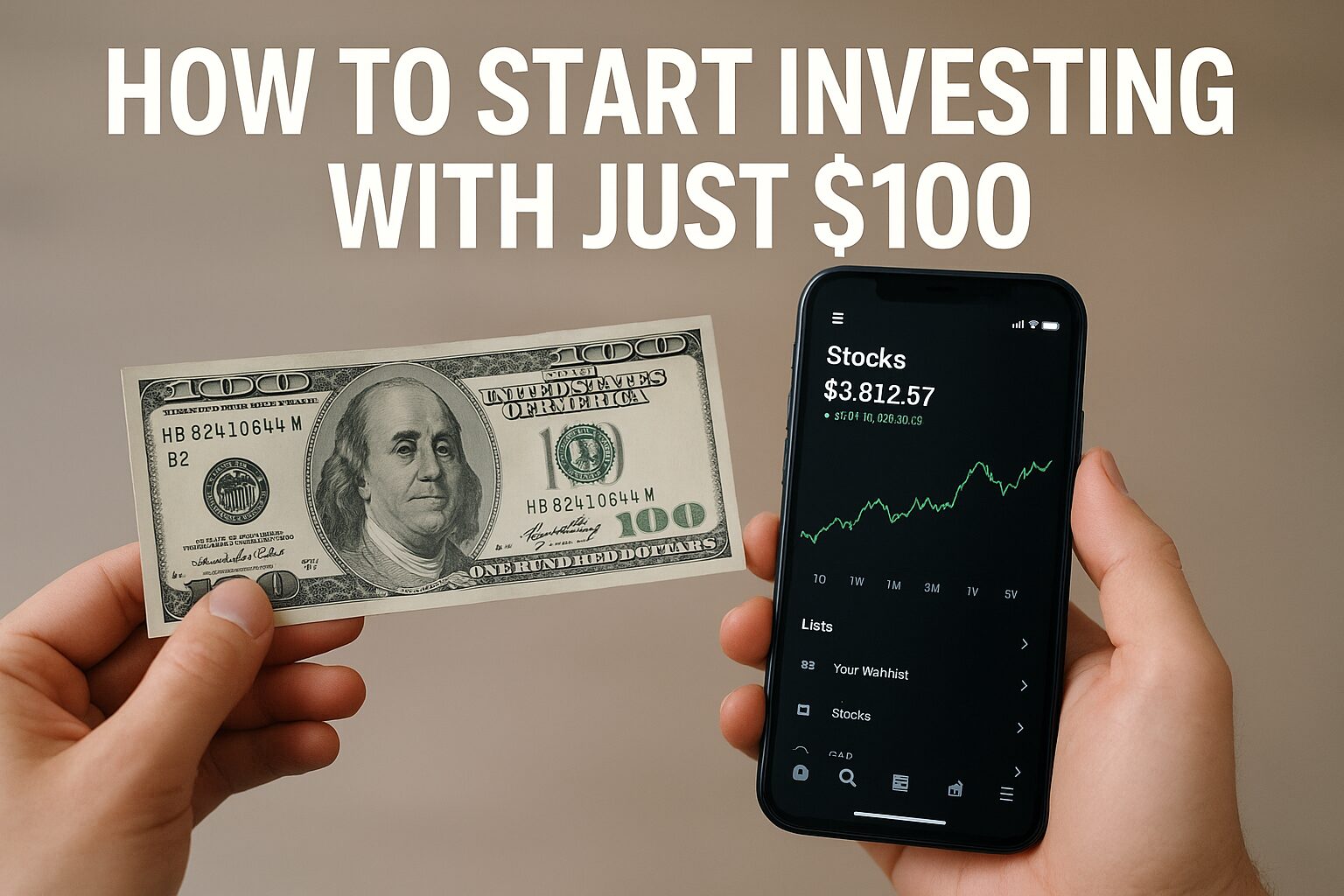When people think about investing, many assume it’s only for the wealthy those with thousands of dollars sitting in their bank accounts. But that’s a common myth. Thanks to today’s digital platforms and low-cost tools, you can start investing with small amounts even just $100.
The truth is, investing isn’t about how much money you start with. It’s about getting started early and building consistent habits. That $100 may not seem like much today, but over time, it can be the foundation of your financial future.
Think of it like planting a seed. You don’t need a forest to start you just need one seed that, with care and patience, grows into something bigger.
How to Start Investing with Just $100
Set Your Goal
Are you investing for long-term wealth, retirement, or short-term growth?
Choose the Right Platform
Look for beginner-friendly apps or brokerages that allow fractional shares and low fees.
Start Small but Smart
Invest in index funds, ETFs, or blue-chip stocks instead of risky picks.
Diversify, Even with $100
Use ETFs or fractional shares to spread your money across multiple companies.
Automate Contributions
Add even $20–$50 regularly. Consistency matters more than the amount.
Reinvest Dividends
Let your earnings generate more earnings through compounding
Avoid High Fees
Skip platforms or funds that charge high management fees.
Keep Learning
Follow financial blogs, podcasts, or courses to grow your knowledge.
Stay Patient
Investing is a marathon, not a sprint. Don’t panic with short-term market swings.
Review & Adjust
Check your portfolio every few months and rebalance if needed.
Benefits of Starting Small
You might wonder: Does investing $100 really matter? Absolutely. Here’s why:
Building the Habit of Investing Early
Starting small helps you develop the habit of saving and investing without feeling overwhelmed. By contributing regularly, you’ll train yourself to treat investing as a priority.
Learning Without Risking Too Much
When you start investing early with smaller amounts, mistakes won’t cost you as much. It’s a safe way to learn how markets and investments work.
The Power of Compound Interest
Even little contributions grow significantly over time. For example, if you invest $100 and keep adding just $25 every month, with an average 7% annual return, your money could grow to over $10,000 in 15 years.
This is the power of compounding—earning interest on your interest.
Best Ways to Start Investing with $100
If you’re wondering how to start investing with $100, here are the best beginner-friendly options:
High-Yield Savings Accounts & Certificates of Deposit (CDs)
- Best for safety: Low risk, government-insured options
- Good for short-term goals: Steady, predictable growth
- While these don’t offer huge returns, they’re a safe first step.
Robo-Advisors
- Automated platforms that build portfolios for you
- Require little to no investing knowledge
- Some let you start with as little as $5–$100
- Great if you prefer a hands-off approach
Fractional Shares of Stocks or ETFs
- Own a “piece” of companies like Apple, Tesla, or Amazon
- ETFs (exchange-traded funds) let you invest in bundles of stocks
- You can start with just $1, making it perfect for beginners
Micro-Investing Apps
- Apps like Acorns round up your purchases and invest spare change
- You can start with tiny amounts, even pennies
- Great for those who want to invest passively without thinking about it
Cryptocurrency (Optional & High Risk)
- You can buy fractions of Bitcoin, Ethereum, or other coins
- Be cautious: prices are highly volatile
- Only invest money you’re willing to lose
Steps to Start Investing (Beginner’s Roadmap)
Here’s a simple step-by-step guide on how to start investing with $100:
- Set your financial goals – Are you saving for retirement, a house, or just building wealth?
- Choose the right platform or app – Brokerage, robo-advisor, or micro-investing app.
- Open an account – Most take less than 10 minutes to set up.
- Deposit your $100 – Treat it as the first step toward financial growth.
- Pick your first investment – Start with something low-cost like ETFs or robo-advisors.
- Monitor and adjust over time – Don’t obsess daily; review quarterly or yearly.
This roadmap is designed to make investing feel less intimidating.
Tips to Grow Beyond $100
Once you’ve started, the key is to keep going.
- Invest regularly – Add $10, $25, or $50 every paycheck.
- Reinvest dividends – Let your earnings buy more shares automatically.
- Avoid emotional investing – Don’t panic sell during downturns.
- Use dollar-cost averaging – Invest the same amount regularly to smooth out market ups and downs.
Mistakes to Avoid When Starting Small
Even with just $100, it’s easy to make mistakes. Here are the most common pitfalls:
- Expecting overnight wealth – Investing is a marathon, not a sprint.
- Putting all $100 in one risky stock or coin – Diversify, even with small amounts.
- Ignoring fees – High fees can eat into your returns, especially on small investments.
Visual/Stats Section
Here’s what $100 could look like if you continue to invest regularly:
Growth of $100 Investment Over 10 Years
| Investment Option | Starting Amount | Monthly Contribution | Average Return | Value After 10 Years |
|---|---|---|---|---|
| High-Yield Savings | $100 | $25 | 1% | ~$3,250 |
| Robo-Advisor (Balanced Portfolio) | $100 | $25 | 5% | ~$3,900 |
| Stock Market (Index Funds/ETFs) | $100 | $25 | 7% | ~$4,300 |
(Values are estimates, not guaranteed returns. For illustration only.)
This shows how small, consistent investing can create big results over time.
FAQs
Q1: Can you really start investing with just $100?
Yes! Thanks to fractional shares, robo-advisors, and micro-investing apps, $100 is enough to begin.
Q2: What’s the safest way to invest $100?
High-yield savings accounts and certificates of deposit (CDs) are the safest, but for growth, low-cost ETFs via robo-advisors are better.
Q3: Is $100 enough to see returns?
Yes, but it’s not about immediate gains. The real benefit comes from consistency and compounding over time.
Q4: Should I invest in stocks or ETFs with $100?
ETFs are usually safer for beginners since they spread risk across multiple companies.
Q5: Can I start investing with no experience?
Absolutely. Robo-advisors and micro-investing apps are designed for complete beginners.
Q6. How can I grow beyond my first $100 investment?
Keep adding money regularly—even $10 or $25 at a time. Reinvest dividends and be consistent. Over years, it adds up.
Q7. Is cryptocurrency a good way to start investing with $100?
You can invest in crypto with $100, but it’s very risky. Only invest what you’re willing to lose, and never put all your money into one coin.
Q8. What mistakes should I avoid when starting with $100?
Don’t expect quick riches, avoid high fees, and never put all your money in one investment. Diversification is key, even with small amounts.
Q9. How do I know if I’m ready to start investing?
If you’ve paid off high-interest debt and have at least a small emergency fund, you’re ready to start investing—even if it’s just $100.
Q10. Can $100 really make a difference for my future?
Yes! It’s less about the amount and more about building the habit. Small investments, made consistently, can turn into thousands of dollars over time.
Conclusion – Small Steps, Big Future
You don’t need thousands of dollars to become an investor. You just need to start investing with small amounts, even if it’s just $100. The key is not the size of your first step, but the fact that you take it. Consistency matters more than the amount. Over time, small contributions can grow into life-changing wealth.
Disclaimer
This article is for educational purposes only and should not be taken as financial advice. Investing involves risks, and returns are not guaranteed. Always do your own research or consult with a licensed financial advisor before making investment decisions.



